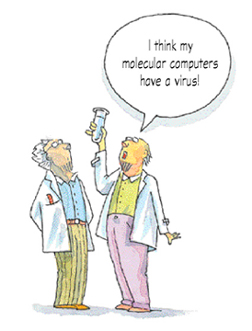Are you a journalist? Please sign up here for our press releases
Subscribe to our monthly newsletter:

Following a newsworthy debut several years ago at the Weizmann Institute, it’s once again making headlines. The world’s smallest computer - a drop of water can hold around a trillion - has now been programmed to perform actions more often associated with doctors than computers: to diagnose and treat cancer.
The computing device successfully identified signs of cancer introduced into a test tube environment, diagnosed the type of cancer and even released an appropriate drug.
Prof. Ehud Shapiro of the Departments of Computer Science and Applied Mathematics and of Biological Chemistry, his research students - Yaakov Benenson, Binyamin Gil and Uri Ben-Dor - and Dr. Rivka Adar have made a splash in the scientific community with their futuristic vision of a “doctor-in-a-cell” that might one day be able to diagnose and treat disease from within, before symptoms even appear. Their study recently appeared in Nature and was presented at the prestigious “Life, a Nobel Story” symposium in Brussels.
The team programmed their computer to detect prostate cancer and one form of lung cancer. The computer evaluates four genes that become either under- or overactive once the disease sets in. The chosen genes control the expression of messenger RNA (mRNA), which carries information from the nucleus to the ribosome, the cell’s protein factory. The scientists introduced different levels of these RNA molecules into the test tube to simulate the presence or absence of cancer.
Made entirely of biological molecules, the computer has three components - input, computation and output. The first consists of short strands of DNA, called transition molecules, which check for the presence of the mRNA produced by each of the four cancer genes. The second component is a computation (diagnostic) unit, consisting of a long hairpin-shaped DNA strand. As the computer’s input segments check for the presence or absence of the four cancer markers, this diagnostic unit checks each input in turn, producing a positive diagnosis of malignancy only if all four markers point to cancer.
This second component also contains the computer’s third component: a single-stranded DNA known to interfere with the cancer cell’s activities. In the case of a positive diagnosis, the unit releases its hold on the therapeutic unit, activating its cancer-fighting potential.
But there’s an added safety feature: if the activity of even one of the four genes is normal (as determined by the test tube levels of the mRNA marker it codes for), the diagnosis is “not cancerous,” and the computer releases a different strand of the computer’s DNA that neutralizes the drug.
The original version of the bio-molecular computer (also in a test tube) was created by Shapiro and colleagues in 2001. This computer was capable of performing mathematical operations such as checking a list of zeros and ones and ascertaining whether all of the zeros precede all of the ones, or whether there is an even number of ones in the list. An improved system, which uses its input DNA molecule as its sole source of energy, was reported in 2003 and was listed in the 2004 Guinness Book of World Records as the smallest biological computing device.
Shapiro: “Our study offers a vision of the future of medicine. It is clear that it may take decades before such a system operating inside the human body becomes a reality. Nevertheless, only two years ago we predicted it would take 10 years to reach where we are today.”

Prof. Shapiro’s research is supported by the Samuel R. Dweck Foundation; the Dolfi and Lola Ebner Center for Biomedical Research; the M.D. Moross Institute for Cancer Research; the Benjamin and Seema Pulier Charitable Foundation and the Robert Rees Fund for Applied Research.